
How Sales Enablement Helps Your Team Generate More Revenue
Sales enablement is the continuous process of providing sales teams with the skills, resources, and coaching they need to improve their performance.

Consistent sales training is the key to exponential revenue growth in any organization.
Why? Because the more skilled your salespeople are, the more effective they become at creating prospects, nurturing them, and converting them into customers at higher margins and opportunity size.
The big questions here are how do you create a program that does this for the new people that join the team, the tenured salespeople that need to polish their skills, and the high performers that want to set records for themselves and your organization? Then, how could you implement a process that monitors their sales skill levels and ensures that everyone continues to improve? How could you implement sales learning paths inside of your organization that set up your company for long-term success?
It is possible to achieve this outcome. We will explain how to go about answering these questions inside this post. Because there’s a lot to cover, we’ve broken it down into these sections.
Having the right sales training plan can make the difference between an average performing sales team and one that regularly overachieves its budget. Let’s learn about how to put together the right sales training program at your organization.

Sales training is the process of developing a salesperson’s skill sets from one measurable level to the next with the goal to improve sales performance.
Sales training happens at various times in an employee’s development. It starts with the onboarding of a new salesperson with the introduction of critical sales skill fundamentals and is revisited regularly as the salesperson grows into a consistent performer at the company.
Elite companies, who clearly understand the benefit of sales training, often pride themselves on having a culture of learning and prioritize sales training as a regular part of their weekly schedule. Not only is their planned sales training done as a whole group, but it is also done on an individual basis.
Related post: How Sales Enablement Helps Your Team Generate More Revenue

Success in sales is entirely dependent on the effectiveness of a salesperson in executing key sales skills that lead to success. A high level of proficiency in these skills results in more wins and more money. There are two ways someone could learn to master these skills. You could spend years of trial and error and just figuring it out as you go, or you could learn how to do these from proven methods inside of a sales training program. With sales training, you could save all the time trying to figure things out and immediately get onto the right path towards success.
These fundamental sales skills range from how to prepare for an effective week, to prospecting, to running effective discovery appointments, to presenting proposals that build value, handling objections and closing for a next step. The top salespeople understand that their skills could always improve in these areas and often hire a sales coach to work with them one on one. The benefits are simple: the better trained you are in these sales skills, the more money you will make. To be more specific, with structured sales training, you will benefit in 4 main areas.
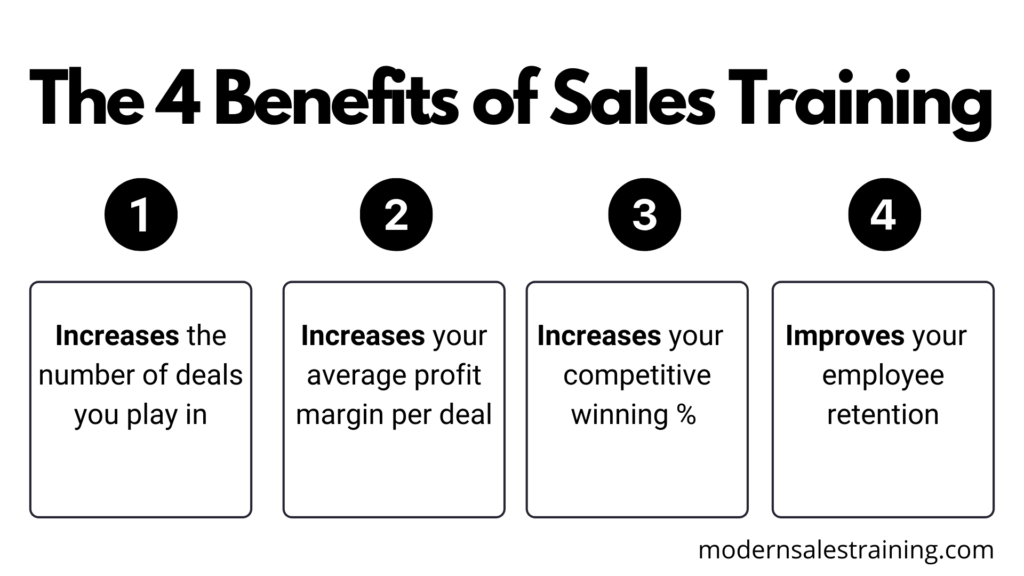
One of the most sought-after topics in sales training is prospecting. The goal is to teach the sales team how to effectively prepare and execute cold calling strategies to set meetings with prospects. The more effective the sales team becomes, the more deals they will have the opportunity to close at the end of the month. The more deals there are to close, the more money the salesperson and the organization will ultimately make.
Most product or service offerings today are highly competitive. The buyer has multiple vendors to choose from that are all selling “the same thing.” With multiple choices comes the search for value. The buyer is looking for the difference between the offerings. Without an obvious difference, the final decision comes down to price. The best sales teams have learned how important it is to differentiate themselves and to build value inside of their deals. Building that value is a hot topic for sales training. The goal is to learn how to bring that extra value from the first engagement with a customer in prospecting, to identifying important information inside of discovery towards tailoring a solution and presenting a custom proposal. The better trained the salespeople are, the more value and likely can sell at a premium price.
Along the lines of building value in a proposal, there’s learning how to build value in regards to the companies themselves. If you have multiple vendors that are offering the same products or services, training is needed to educate the customer on why they should choose one vendor over another. This sort of differentiation is needed when the lines between offerings are very competitive. The better the sales team can be in explaining “why us,” the more deals they will win against their closest competitors.
Finally, sales training is a tool to keep employees motivated and driven towards taking the next step in their careers. One of the common reasons salespeople leave a company falls under “not enough training opportunities.” All people want to feel like they are improving themselves and increasing their skills. If people feel like they have learned all they can learn at your company, they will start to look for another challenge elsewhere. Because of this fact, large organizations tend to create sales learning paths for their employees to always have the opportunity for growth, to challenge themselves, and give them the chance to improve their sales skills which will earn them more money.

There are many different methods of sales training one could do for themselves or their sales team. They each have their own unique way of leveling up sales skills.
Sales consulting can be done for anyone looking to improve their sales skills, sales process at their organization and their sales results. This often is viewed as a sales coach. This one-to-one type of learning engagement tends to be the most expensive as it has the highest return on investment. Some organizations go so far as to hire the sales consultant as a temporary vice president of sales to help put the right programs in place for long-term results.
There are thousands of sales books that one could find in bookstores and on Amazon. What you will notice is most of them focus on the entire sales cycle and the lessons are often repeated. Because of how similar the books can be, the best ones to purchase are the books that explore creating a positive mindset and habits around the way you think. Books like The Greatest Salesman in the World and How to Win Friends and Influence People will never go out of style.
Sales boot camps are ideal when looking for a crash course in how to sell. They typically are for new hires in an organization and the content is around the fundamentals of selling. The smaller the group the better as it provides more time for role play and expanding upon critical topics. You can find multiple sales training programs that offer an all encompassing training around the sales process.
Sales workshops are more commonly focused around 1 to 2 sales skills that someone is looking to improve. This is typically done in person. The most common ones you will find are around goal setting to help with the sales mindset and cold calling methods in prospecting. Those two topics are general enough to not have to concern yourself with too much customization.
Since 2015, online learning has become more popular with on demand courses. Now you can choose to take a sales course designed specifically to be a one-on-one sales workshop around a specific topic. Because it isn’t an in person live event and can be taken at your own pace, the costs for these types of sales trainings are very affordable.
The global pandemic started the rise of zoom classes. Since sales teams had to adjust from meeting in person to meeting online, live sales training classes have become more regular than ever. Like sales workshops, they are made to cover 1 to 2 topics at a time and best with smaller groups to ensure the material is covered and practiced thoroughly with the attendees.

Many businesses use sales training incorrectly and as a result, it has limited benefits. Sure there might be a slight improvement in moral and motivation but it will eventually disappear once the sales organization goes back into their daily habits and routines. To avoid this, it’s important to understand how to avoid the wrong ways of doing sales training.
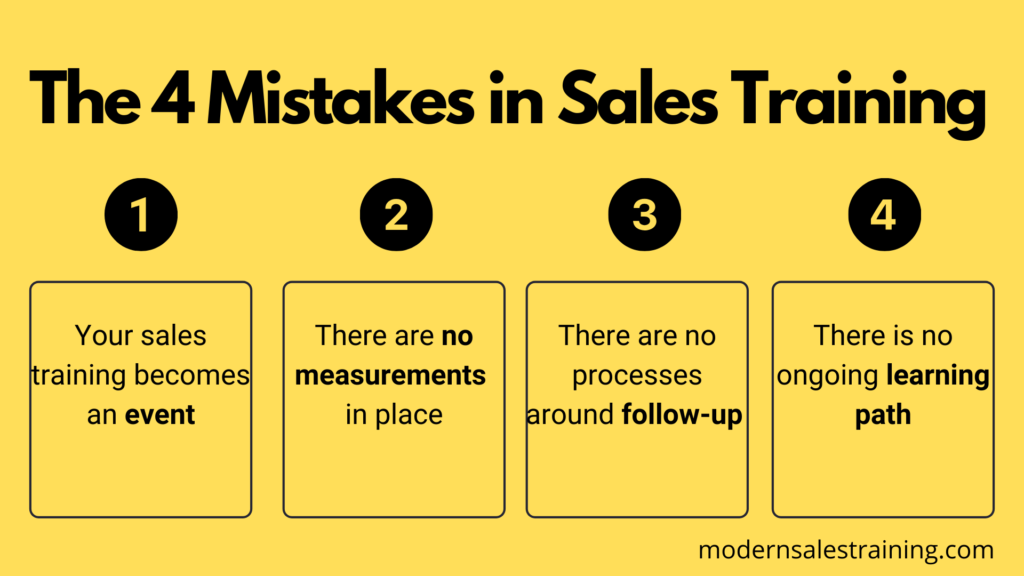
The most common way sales training is done wrong is when it is held in a one-size-fits-all event. One problem with this type of sales training is that there are multiple levels of experience that are involved inside of the training from new hires to tenured salespeople, major account sales teams and sales leadership. It’s nearly impossible to tailor the material to everyone in the room. This type of sales training is considered a “check the box” event, as it can be said the leadership team provided sales training to the sales force, and now that it’s done they don’t need to do it again. If they are all in the room at the same time, it’s easy to say the entire sales team was trained. The other reasons a sales training event is not effective is when there are no measurements in place.
Sales training is done for the purpose of improving skill sets and performance. In order to know if skills are improving, there must be tracking to show the skill someone is at today. Most sales trainings aren’t built with the structure of how we measure if the sales training was successful or not? This is a big miss for businesses doing sales training today.
Let’s take how fast someone is at typing on the computer. The averaging typing speed of someone who is proficient at typing is 36 words per minute. Before you start training on how to type faster, you need to understand how fast the learner can type today. If someone is already typing faster than 36 words per minute, they wouldn’t be a good fit for the training. They would be better fit for a more advanced training. However, if someone is typing 5 words per minute then after the training you could determine how much faster they are at typing. Having measurements like this, can show how effective the training was.
The same thought process goes for sales training. Before any sales training, there should be an understanding of the skill level of the people in the audience that you could evaluate using accessible data. In sales we typically refer to the CRM for this type of information. Let’s take prospecting for example. How many dials does a salesperson need to make before they will set an appointment? That number is something you should know before going through a cold calling training. Then, after the training, you could measure to see if that ratio of “dials to appointments” set improved or not.
Another mistake businesses make with sales training is there is no process around following up on a sales training.
The reason why there’s no follow up is because there’s typically nothing being measured outside of “are we selling more as an organization?” The target measurement needs to be clear that performance could be changing entirely because of the effect of the sales training. That requires a long-term approach to any sales training and building in processes to inspect those target metrics and follow up with coaching to reinforce and improve results.
This type of sales process is an essential part of any winning organization for the reason that they are constantly measuring how they are improving in every target category and at every level of the sales operation.
Follow up done right, is revisiting the material to keep it fresh inside of weekly trainings, looking at the individual data and sales coaching to improve inside of one on ones, and inserting the material into their normal learning paths of the organization.
Sales training can also be designed properly to not be an event, have good measurements and follow up in place and still end up failing in the end. The reason it fails is because there is no path for continuous improvement.
A prime example of this is sales new hire. A new employee starts at an organization, is taught how to sell with the other new recruits and once that is over the learning is done. There is nothing else to learn except from their peers and on the job experience.
This is why it is so important to create learning paths for the sales employees. How can they keep developing their skills after new hire? What training is happening weekly with the sales team? What skills are they being refreshed on a daily, weekly, monthly basis? How is the sales messaging being reinforced or built upon with more advanced training? Is there a feedback system to constantly improve the sales new hire training to be up to date with what the rest of the team is learning?
This can all be figured out when you learn the framework around how to build your own sales training program at your organization.

Now that we’ve gone over what sales training is, the many benefits they provide, the different types of sales training, and how organizations do them wrong, let’s explore how you can create a sales training program that works for your business. To begin, let’s look at the 7 components to an effective sales training program.
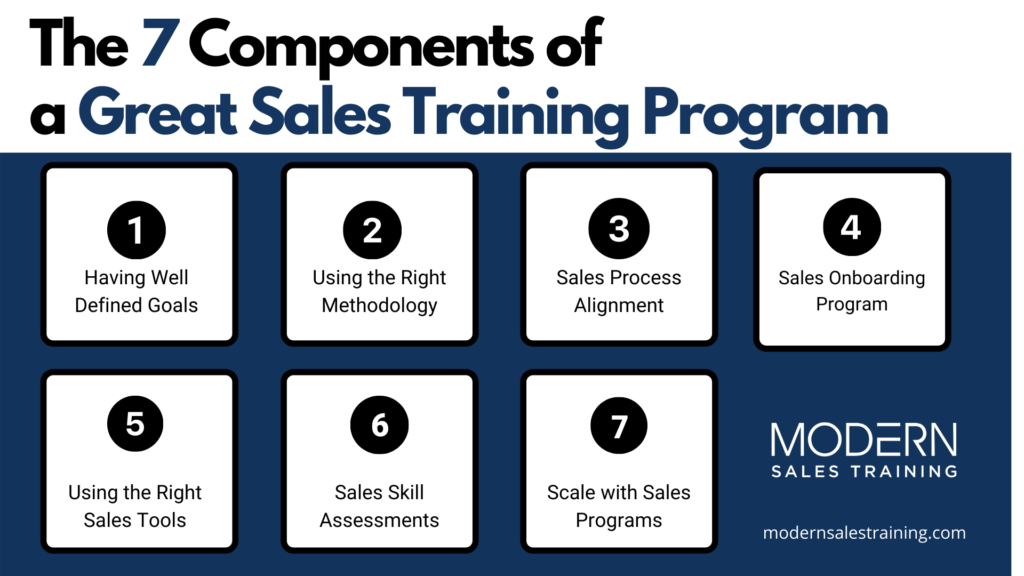
Before any sales training program is created, it’s recommended to first decide upon the outcomes you are looking to achieve in the trainings. You do this by analyzing the data your organization is tracking now and finding the hidden opportunities for improvement. Let’s say you are exploring the amount of new business your company is currently bringing in today.
Some example questions to help you reflect and analyze:
You can use the same process of analyzing as an individual trying to improve.
Are you achieving your sales plan at the moment? The goal should be to overachieve on the compensation plan given to you by your organization. Your goal needs to be consistency and hitting every category. What skill sets do you need to improve to help you do that?
After analyzing the data, decide upon the goals you would like to achieve moving forward.
The next part to consider is the sales methodology you use to achieve your goals. There are many different options and they are best utilized with certain types of sales processes. For example, if you are in a more transactional sales environment where it’s common to close a deal every day, then you wouldn’t want to use the Challenger methodology as it would extend the length of the buying process. On the other hand if you want to build a considerable amount of value in your sales process, you might now want to use SPIN selling techniques.
Deciding upon the right methods is important as your entire sales force and sales process should be acting from the same sales playbook. Learning one way in training and then observing your manager follow a completely different philosophy is a fundamental error in a sales process.
All top business to business (b2b) sales organizations have a proven sales process they follow religiously and execute daily. They use the process to find the right customers at the right time with the right message. They use this process to qualify opportunities and forecast business they can count on in the future. They use this process to help with time management and skill set improvement. Without a sales process in place, they would be leaving their success to chance.
Related Content: How to create a sales process that accelerates growth
Well defined goals, a sales methodology that is designed to reach them and a sales process that everyone on the team understands is a recipe for success. From here it needs to be determined on how you will onboard new salespeople into this process going forward.
A sales onboarding program is one that’s constantly evolving to better prepare new salespeople for success in your company.
This means that as goals and sales strategies change, the onboarding is modified to match the new changes. When a new sales employee starts they need to be completely aligned with the company culture and the goals of the organization. They need to clearly understand all of the critical information around what they sell and the sales process they are following in their deals and finally, they need to be taught how to sell in today’s modern sales world. Every piece of information they are trained on needs to be designed around creating the perfect sales professional that will be set up for success.
There are a wide variety of sales tools available in the market today. That doesn’t mean you need to use all of them. There are tools that will record your calls and meetings and help you analyze the words that were said, and tools that will help you create proposals and send over contracts. Like any tool, they have a purpose so you will need to find the ways that help your team sell more effectively using the strategy provided for them in the sales process.
One mandatory tool, however, is the CRM. Using a customer relationship management (CRM) software that helps you track and analyze data is necessary to grow your business so choose one knowing that it will always be a source of complaints from your sales team. Because companies want to bypass the comment, “our CRM is awful,” they tend to choose Salesforce, as they are as good as it gets.
As follow up tends to be a major problem with sales training, it’s critical to build in sales skill assessments inside of your sales training program and sales process. These skill sets are ways to identify the proficiency of your sales team. Sales assessments are also methods to ensure your salespeople retain what they learned inside of training and are still utilizing it in their daily activities.
Some common ways of sales skill assessments are to revisit sales training inside of monthly one on ones, field ride days, and regular skill certifications.
Learning paths are a critical part of growing your business. That’s why adding to your current sales training program is a major component of improving your results. Here are some questions to help you consider where you might start to add new sales training programs into your sales process.
Keep in mind that as you add to your sales training programs, you will have to go back and update everything else to ensure alignment across the learning paths.

You may not be prepared to put together sales training programs just yet for your company. That’s OK! There are plenty of other sales training programs that exist that can meet that need while you grow your business.
Sales training programs fall under two main categories:
Comprehensive sales training is one that could be applied to the entire sales organization and commonly is used as a new hire sales onboarding program. The main focus of these types of training programs is to introduce methodologies that could be used to teach the sales fundamentals to salespeople. They can be done in an in-person workshop setting, live sales class online, in an on demand course or a blend of these options.
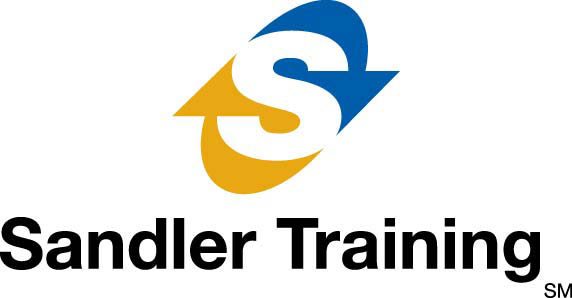
Certified Sales Associate (CSA), from Sandler, focuses on training reps to uncover client pain points. Follow-up sales reinforcement training is also offered by this training provider. The classroom and online sales training programs aim to empower professionals to change behaviors, develop new attitudes, and improve sales techniques. Sandler trainers encourage participants to question belief systems and long-held assumptions. The sales training program aims to empower learners to replace nonproductive habits and to build sustainable action plans, leading to consistent sales mastery.

Carnegie’s sales training program, Winning with Relationship Selling, follows five critical steps. With its customer-first approach, the selling process aims to develop a strategic vision and determine your specific organizational needs. Working with employees at all levels of your organization, the training sessions focus on modelling long-term behaviors to drive your organization toward its sales goals.
Sales In 21 Days is an online sales course bundle that’s creating top sales performers on sales teams all over the world. It is an 18-hour e-learning course that focuses on the critical top performer skills used during the full business to business (B2B) sales cycle. Over 15,000 salespeople and sales teams use these courses regularly to level up their sales skills.
Focused sales training is one that zeros in on a particular skill set needed by a smaller group within an organization. The main focus of these types of training programs is to make improvements in areas like prospecting, discovery and finding opportunity, and negotiation and closing strategies. They can be done in an in-person workshop setting, live sales class online, in an on demand course or a blend of these options.
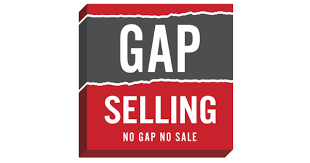
GAP Selling, from A Sales Guy, is a training that focuses around discovery on the first appointment with a client. The training will walk you through how to identify the gap in an organization’s current process and how your offering could help them bridge the gap to faster success.

As an FBI hostage negotiator, Chris Voss persuaded terrorists, bank robbers, and kidnappers to see things his way. Now he’s teaching you his field-tested strategies to help you in everyday negotiations, whether you’re aiming to improve your salary, the service you receive, or your relationships. Get stronger communication skills, game-changing insights into human nature, and more of what you want out of life.
The Fearless Prospector is an online sales training course that teaches new or tenured salespeople how to conquer fear in prospecting, proven strategies to flood their calendars with appointments, and how to get in control of their sales destiny. It is an 8-hour e-learning course that focuses on the critical cold calling skills used to plan for effective weeks in the field and tactics on how to get past gatekeepers in person, and over the phone, during the full business to business (B2B) sales cycle

Imagine earning exponentially more money this year compared to last. Would that be life changing?
Well there are two ways that could become a reality. You could continue to do things the way you are doing them right now, and hope to get lucky in the process, or you can start putting together a sales training strategy for your company and create a learning path designed for sales success.
To help you along that path, we’ve put together a free course designed to show you how effective a one hour online sales training could be, in developing your salespeople into top sales performers. If you have any questions along the way, feel free to reach out and set up a quick call.

Sales enablement is the continuous process of providing sales teams with the skills, resources, and coaching they need to improve their performance.

A sales process is a set of repeatable steps that a sales organization does to find the right buyer, get them interested in their product or service and close them in a predictable timeframe.

“It always comes down to price…”
In the first bonus sales training episode of the In Between Sales Calls Podcast, Jason Scoggins shares a practical tip on how you can go the extra mile in sales and improve your results in your sales career.